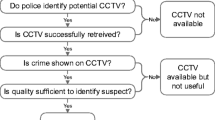Abstract
One of the most relevant applications of digital image forensics is to accurately identify the device used for taking a given set of images, a problem called source identification. This paper studies recent developments in the field and proposes the mixture of two techniques (Sensor Imperfections and Wavelet Transforms) to get better source identification of images generated with mobile devices. Our results show that Sensor Imperfections and Wavelet Transforms can jointly serve as good forensic features to help trace the source camera of images produced by mobile phones. Furthermore, the model proposed here can also determine with high precision both the brand and model of the device.



Similar content being viewed by others
References
Bayram S, Sencar HT, Memon N (2008) Classification of digital camera-models based on demosaicing artifacts. Digit Investig 5(1–2):49–59
Boutell M, Luo, J (2004) Photo classification by integrating image content and camera metadata. In: Proceedings of the 17th international conference on pattern recognition, vol 4. IEEE Computer Society, pp 901–904. doi: 10.1109/ICPR.2004.1333918
Boutell M, Luo J (2005) Beyond pixels: exploiting camera metadata for photo classification. Pattern Recogn 38(6):935–946. doi:10.1016/j.patcog.2004.11.013
Celiktutan O, Avcibas I, Sankur B, Ayerden NP, Capar C (2006) Source cell-phone identification. In: 2006 IEEE 14th signal processing and communications applications, pp 1–3. doi: 10.1109/SIU.2006.1659882
Chang C, Lin C (2001) LIBSVM: A library for support vector machines. Tech. rep. Software available at: http://www.csie.ntu.edu.tw/cjlin/libsvm
Do MN, Vetterli M (2005) The contourlet transform: an efficient directional multiresolution image representation. IEEE Trans Image Process 14(12):2091–2106
Geradts ZJ, Bijhold J, Kieft M, Kurosawa K, Kuroki K, Saitoh N (2001) Methods for identification of images acquired with digital cameras. In: Proceedings of the SPIE, vol 4232. Spie, pp 505–512. doi: 10.1117/12.417569
Khannaa N, Mikkilinenib AK, Chiub GT, Allebacha JP, Delpa EJ (2006) Forensic classification of imaging sensor types. In: Rfc. Purdue University, USA
Luka J, Fridrich J, Goljan M (2006) Digital camera identification from sensor pattern noise. IEEE Trans Inform Forensics Security 1(2):205–214. doi:10.1109/TIFS.2006.873602
Mckay C, Swaminathan A, Gou H, Wu M (2008) Image acquisition forensics: forensic analysis to identify imaging source. In: IEEE international conference on acoustics speech and, signal processing, pp 1657–1660. doi: 10.1109/ICASSP.2008.4517945
Meng FJ, Kong XW, You XG (2008) Source camera identification based on image bi-coherence and wavelet features. In: Proceedings of the fourth annual IFIP WG 11.9 international conference on digital forensics. Kyoto, Japan
Ozparlak L, Avcibas I (2011) Differentiating between images using wavelet-based transforms: a comparative study. IEEE Trans Inform Forensics Security 6(4):1418–1431
Pudil P, Novovičová J, Kittler J (1994) Floating search methods in feature selection. Pattern Recogn Lett 15(11):1119–1125
Randen T, Husøy JH (1999) Filtering for texture classification: a comparative study. IEEE Trans Pattern Anal Mach Intell 21(4):291–310
Baer R (2010) Resolution limits in digital photography: the looming end of the pixel wars - OSA technical digest (CD). In: Proceedings of the imaging systems. Optical Society of America, p ITuB3
Romero NL, Chornet VG, Cobos JS, Carot AS, Centellas FC, Mendez MC (2008) Recovery of descriptive information in images from digital libraries by means of EXIF metadata. Library Hi Tech 26(2):302–315. doi:10.1108/07378830810880388
Tesic J (2005) Metadata practices for consumer photos. IEEE Multimed 12(3):86–92. doi:10.1109/MMUL.2005.50
Tsai MJ, Lai CL, Liu J (2007) Camera/mobile phone source identification for digital forensics. In: Proceedings of the IEEE international conference on acoustics speech and signal processing ICASSP 07, pp II-221-II-224
Van Lanh T, Chong KS, Emmanuel S, Kankanhalli MS (2007) A survey on digital camera image forensic methods. IEEE Int Conf Multimed Expo 2007:16–19. doi:10.1109/ICME.2007.4284575
Wang B, Guo Y, Kong X, Meng F (2009) Source camera identification forensics based on wavelet features. In: Proceedings of the international conference on intelligent information hiding and multimedia signal processing, vol 0. IEEE Computer Society, Los Alamitos, pp 702–705
Acknowledgments
This work was supported by the Agencia Española de Cooperación Internacional para el Desarrollo (AECID, Spain) through Acción Integrada MAEC-AECID MEDITERRÁNEO A1/037528/11.
Author information
Authors and Affiliations
Corresponding author
Rights and permissions
About this article
Cite this article
Sandoval Orozco, A.L., Arenas González, D.M., Rosales Corripio, J. et al. Source identification for mobile devices, based on wavelet transforms combined with sensor imperfections. Computing 96, 829–841 (2014). https://doi.org/10.1007/s00607-013-0313-5
Received:
Accepted:
Published:
Issue Date:
DOI: https://doi.org/10.1007/s00607-013-0313-5




